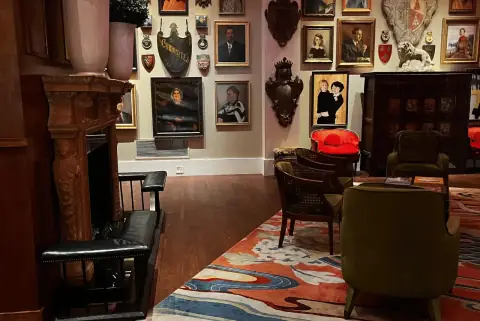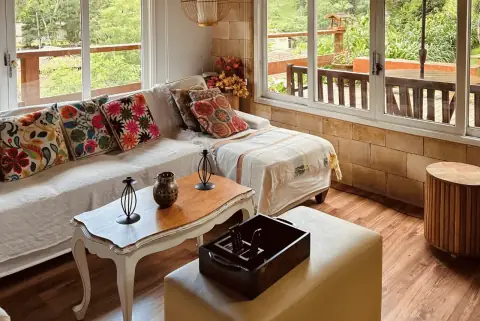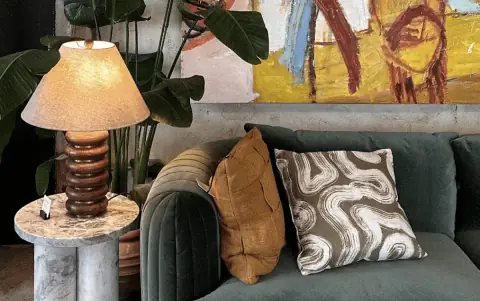Maximalist interior design isn’t for the faint of heart—it’s bold, expressive, and unapologetically extra. It’s a style that embraces your love for art, patterns, color, texture, and all those quirky little treasures you’ve picked up over the years. Think of it as your personality, splashed across every corner of your colorful home design.
At its best, maximalism is a joyful layering of favorite pieces—vintage finds, gallery walls, velvet sofas, loud wallpaper, stacked books, and sentimental knickknacks—all mingling together in colorful harmony.
Every maximalist space ends up being as unique as the person creating it, which is kind of magic.
But make no mistake: “more is more” doesn’t mean “just keep adding.” The real trick is editing. When you’re walking that line between beautifully curated and visually cluttered, a little thought goes a long way. A few smart maximalist decor ideas can keep things playful without turning your space into chaos. When in doubt, think of maximalism as organized expression—there’s a method to madness, and it’s all about balance.
A Style with History
Maximalist design has been around for centuries, with the Victorian era being a standout moment. Back then, it was all about layering luxe textures, ornate decor, and treasured finds as a way to show off wealth and personal taste. Today, that spirit lives on in cozy styles like English cottage and French country—designs that also celebrate comfort, charm, and meaningful pieces.
Why It’s Trending Now
Maximalism has seen a major revival, especially among millennials and younger generations who want their homes to reflect who they are—not just follow a neutral trend. It’s colorful, expressive, and full of personality, which makes it a favorite on social media (and in real life).
What Maximalism Looks Like

This style is all about joy and self-expression. Think bold furniture, layered patterns, vintage treasures, book-filled shelves, plantlife, and art you love. The trick is to start with one or two standout features—like a plush velvet chair or a gallery wall—and build around them thoughtfully.
The Balance of Bold and Cozy
Even though maximalism loves a good visual mix, it still needs a sense of order. Too many items without intention can tip the space from vibrant to overwhelming. Keep the focus on what brings you comfort and joy—and mix in layers that feel lived-in, not chaotic.
If it makes you smile, it belongs. That’s the heart of maximalist design.
Maximalism Made Easy: How to Design Boldly Without the Chaos
How to decorate like a maximalist? If you love color, texture, and storytelling through design—but feel overwhelmed by how much is too much—don’t worry, you’re not alone. Maximalism doesn’t mean cramming every shelf or painting every wall a neon hue. It’s about creating a space that’s rich in personality, filled with things that make you happy, and still feels put-together. The key? Bold choices with balance.
Start with a Neutral Foundation

Before layering in color and pattern, build your room on a calm base. Choose visually quiet pieces for big-ticket items—sofas, curtains, rugs, and shelving—in neutral tones or natural textures. These pieces act like a blank canvas, giving your eye a place to rest and making your accents shine. It also gives you flexibility to swap out patterns or colors later without redoing the entire room.
Choose Statement Pieces Over Clutter
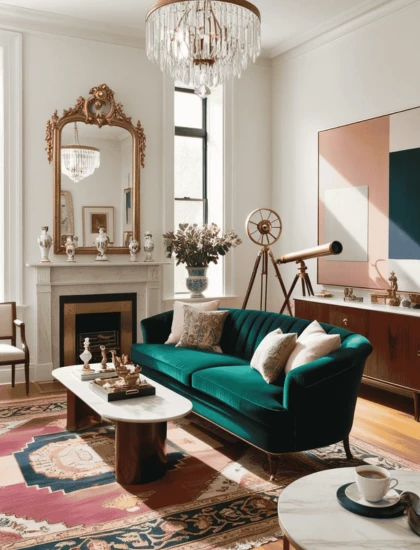
More isn’t always better. Maximalism without clutter is about meaningful abundance, not mess. Anchor your space with one or two showstoppers—a boldly patterned armchair, a vibrant gallery wall, or an ornate cabinet. From there, you can build layers without overwhelming the space.
Mix Patterns the Smart Way
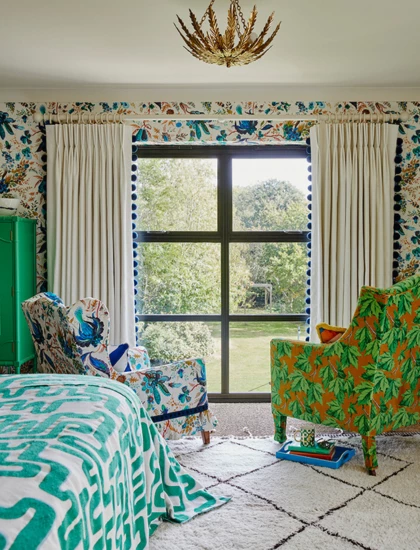
Want to pair florals with stripes or geometrics with animal print? Go for it—but keep one common thread, like a shared color or scale. Limit pattern mixing to a few surfaces at a time (pillows, rugs, throws) and give them space to play off neutrals or solids nearby.
Layer with Intention
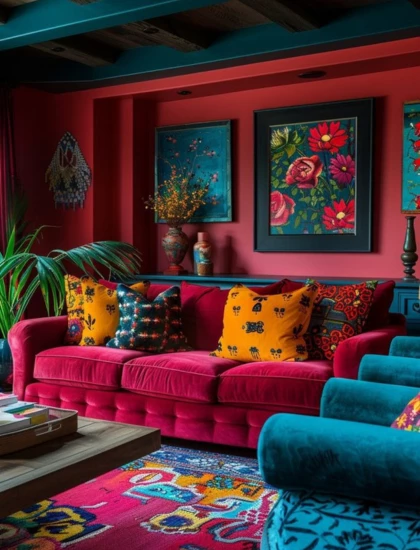
Maximalist spaces feel lived-in, not thrown together. Use height and depth when styling shelves, tables, or mantels—stack books, lean art, and mix in smaller objects like planters or travel finds. Slightly staggered arrangements feel natural and give each piece its moment. Avoid lining everything up or making it feel too symmetrical.
Balance Bold with Calm

Maximalism works best when the room feels collected, not crowded. Mix visual weight—if a piece of furniture is bulky or dark, balance it with something light, open, or airy nearby. That contrast keeps the space from feeling too heavy or too sparse.
Use Negative Space Like a Pro
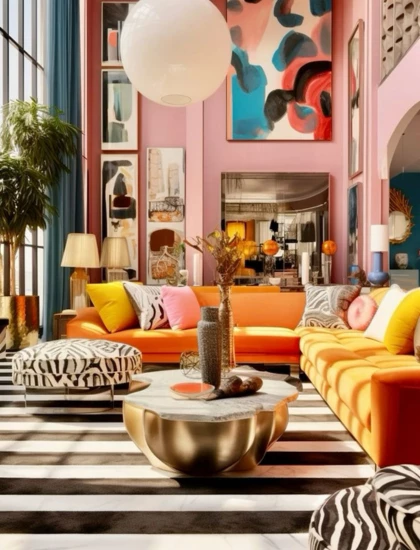
Every inch doesn’t need to be filled. Let standout pieces breathe by giving them room to shine. A striking artwork might look best on its own wall. A bold chair could pop in an otherwise simple corner. White space isn’t boring—it’s strategic.
Hide the Everyday Stuff
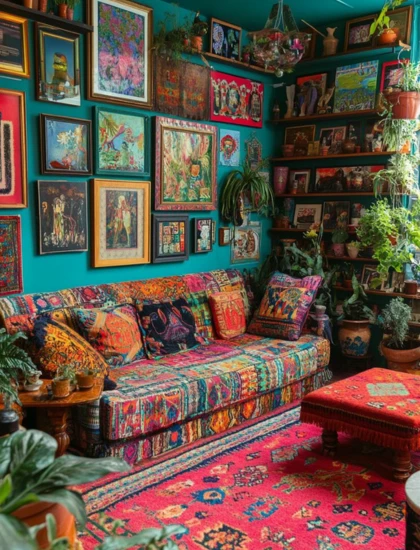
To keep your space feeling styled rather than chaotic, tuck away non-decorative items (think cords, toiletries, random paper piles). Decorative storage—like trunks, woven baskets, or unique cabinets—lets you keep your personality on display while still being practical.
Tell Your Story
Finally, give your room a point of view. Whether it’s travel-inspired, vintage glam, cozy eclectic, or a blend of everything you love, think about what you want the space to say about you. When each piece connects to a story, even the busiest rooms feel cohesive.
Maximalism isn’t about perfection—it’s about expression. With the right balance, it can be cozy, joyful, and completely livable. When you layer with intention, mix what you love, and let your personality guide the way, you’re not just decorating—you’re creating a space that feels boldly, beautifully you.
READ MORE:These Bridgerton Inspired Home Decor Is Giving Regencycore Vibes

